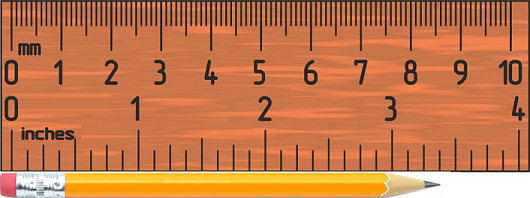IMPERIAL MEASURES OF LENGTH
Subscribe to our ▶️ YouTube channel 🔴 for the latest videos, updates, and tips.
People have been measuring for thousands of years. Early trades people created their own measuring devices and units.
For example, people measured the distance between two places by the number of days it took to travel from one place to the other.
Over time, these units were standardized as imperial units, and relationships between the units were determined.
The imperial unit for measuring long distances is the mile. The length of one mile was first established as the distance a Roman soldier could walk in 1000 paces. One pace is 2 steps.
Imperial Unit
Abbreviation
Referent
Relationship between Units
Inch
in.
Thumb length
Foot
ft.
Foot length
1 ft. = 12 in.
Yard
yd.
Arm span
1 yd. = 3ft
1 yd. = 36 in.
Mile
mi.
Distance travelled in 10 min
1 mi. = 1760 yd.
1 mi. = 5280 ft.
Many rulers marked with imperial units show one inch divided into eighths, tenths, or sixteenths. To measure the length of an object, you must first determine the smallest indicated unit by counting the number of divisions between two adjacent inch marks.
The bottom part of the ruler below has 8 divisions between two adjacent inch marks, so the smallest indicated unit is 1/8 of an inch, which is written as 1/16 in.

The pencil point is closest to the 3rd division mark between 3 in. and 4 in., so its length is 3⅜in.
A fraction of an imperial measure of length is usually written in fraction form, not decimal form.
Converting Between Imperial Units
Example 1 :
Convert 8 yd. to feet.
Solution :
Since 1 yd. = 3 ft., to convert yards to feet multiply by 3.
8 yd. = 8 x 3 ft.
= 24 ft.
Example 2 :
Convert 7 yd. to inches.
Solution :
Since 1 yd. = 3 ft. and 1 ft. = 12 in., multiply the given yards by 3 to convert it to feet, further, multiply the result by 12 to convert it to inches.
7 yd. = 7 x 3 ft.
= 21 ft.
= 21 x 12 in.
= 252 in.
Example 3 :
Convert 53 in. to feet and inches.
Solution :
Since 12 in. = 1 ft., to convert inches to feet, divide by 12.
53 in. = (53/12) ft.
12 goes into 51, 4 times and 5 left over.
Therefore,
53 in. = 4 ft. and 5 in.
Example 4 :
Convert 55 in. to yards, feet, and inches.
Solution :
Since 12 in. = 1 ft., to convert inches to feet, divide by 12.
55 in. = (55/12) ft.
12 goes into 55, 4 times and 7 left over.
55 in. = 4 ft. and 5 in.
Since 3 ft. = 1 yd., to convert feet to yards, divide by 3.
3 goes into 4, 1 time and 1 left over.
55 in. = 1 yd., 1 ft. and 5 in.
Solving a Problem Involving Converting between Units
Example 5 :
James is framing a picture. The perimeter of the framed picture will be 140 in.
(a) What will be the perimeter of the framed picture in feet and inches?
(b) The framing material is sold by the foot. It costs $1.55/ft. What will be the cost of material?
Solution :
Part (a) :
Given : Perimeter = 140 in.
To convert inches to feet, divide by 12.
140 in. = (140/12) ft.
12 goes into 140, 11 times and 8 left over.
140 in. = 11 ft. and 8 in.
Part (b) :
The perimeter of the framed picture is greater than 11 ft., so James must buy 12 ft. of framing material.
The cost of the framing material :
= 12($1.55)
= $18.60
Solving a Problem Involving Two Unit Conversions
Example 6 :
The school council has 6 yd. of fabric that will be cut into strips 5 in. wide to make decorative banners for the school dance. How many banners can be made?
Solution :
Since the width of a banner is measured in inches, convert the length of the material to inches.
Since 1 yd. = 3 ft., multiply the given yards by 3 to convert it to feet.
6 yd. = 6 x 3 ft.
= 18 ft.
Since 1 ft. = 12 in., multiply the 18 ft. by 12 to convert it to inches.
= 18 x 12 in.
= 216 in.
Since each strip is 5 in. wide, divide 216 in. by 5 to find the number of banners.
= 216/8
= 43.2
Therefore, 43 banners can be made with 6 yd. of fabric.
Solving a Problem Involving Scale Diagrams
Example 7 :
A map of Alaska has a scale of 1 : 4,750,000. The distance on the map between Paxson and the Canadian border is 3⅗ in. What is this distance to the nearest mile?
Solution :
The map scale 1 in. represents 4,750,000 in.
3⅗ in. represents
= 3⅗ in. (4,750,000)
= (18/5)(4,750,000)
= 17,100,000 in.
Divide by 12 to convert 17,100,000 in. to feet :
= 17,100,000/12
= 1,425,000 ft.
Divide by 5280 to convert 1,425,000 ft. to miles :
= 1,425,000/5280
≈ 270 mi.
The distance between Paxson and the Canadian border is approximately 270 mi.
Subscribe to our ▶️ YouTube channel 🔴 for the latest videos, updates, and tips.
Kindly mail your feedback to v4formath@gmail.com
We always appreciate your feedback.
About Us | Contact Us | Privacy Policy
©All rights reserved. onlinemath4all.com

Recent Articles
-
ASTC Formula in Trigonometry
Dec 23, 25 11:34 PM
ASTC Formula in Trigonometry - Concepts - Examples and Solved Problems -
Coin Tossing Probability
Dec 23, 25 11:29 PM
Coin Tossing Probability - Concept - Sample Space - Formula - Solved Problems -
Permutation and Combination
Dec 23, 25 11:28 PM
Permutation and Combination - Definition - Formulas - Shortcuts - Difference between permutation and combination
